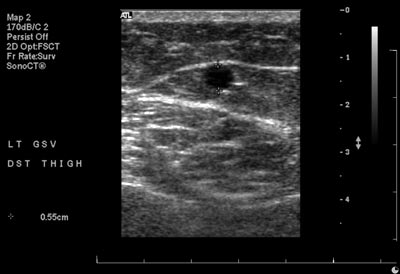Vein mapping

Ultrasound showing diameter of saphenous vein
When lower extremity arterial bypass surgery is required, a bypass graft using a vein often provides the best long-term result. Using the person's own tissue reduces the risk of infection or thrombosis (clotting) of the graft. Vein grafts are also used for coronary artery bypass grafts and other purposes. The most commonly used vein is the greater saphenous vein from the lower extremity, but other superficial veins in the upper or lower extremities may be used, if needed.
It is important that the vein segments used for bypass grafts are healthy. Some vein segments may be diseased and unsuitable. In other cases, vein segments may have been removed for other operations.
Preoperative ultrasound imaging can evaluate vein segments that might be used for bypass grafts, providing the surgeon with information that may guide the planned operation.
No special preparation is required. A complete study usually takes about 30 to 60 minutes.
One or more extremities may be examined, depending on the clinical circumstances. When requested by the surgeon, the course of the vein will be marked on the skin with indelible ink.
See also:
Diseases, conditions and their treatments: Peripheral artery disease (PAD)
Diseases, conditions and their treatments: Critical limb ischemia
Vascular Laboratory exams: Bypass graft evaluation
Vascular Laboratory exams: Peripheral arterial duplex scanning
Vascular Laboratory exams: Treadmill exercise testing
